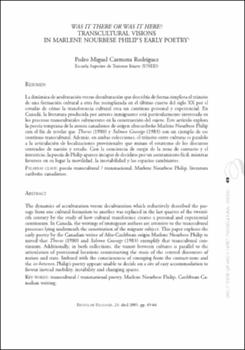Was is there or was it here?: transcultural visions in Marlene Nourbese Philip's early poetry
Fecha
2005Resumen
La dinámica de aculturación versus deculturación que describía de forma simplista el tránsito
de una formación cultural a otra fue reemplazada en el último cuarto del siglo XX por el
estudio de cómo la transferencia cultural crea un continuo personal y experiencial. En
Canadá, la literatura producida por autores inmigrantes está particularmente interesada en
los procesos transculturales subyacentes en la construcción del sujeto. Este artículo explora
la poesía temprana de la autora canadiense de origen afrocaribeño Marlene Nourbese Philip
con el fin de revelar que Thorns (1980) y Salmon Courage (1983) son un ejemplo de ese
continuo transcultural. Además, en ambas colecciones, el tránsito entre culturas es paralelo
a la articulación de localizaciones provisionales que minan el estatismo de los discursos
centrados de nación y estado. Con la conciencia de surgir de la zona de contacto y el
intersticio, la poesía de Philip aparece incapaz de decidirse por un asentamiento fácil, mientras
favorece en su lugar la movilidad, la inestabilidad y los espacios cambiantes. The dynamics of acculturation versus deculturation which reductively described the passage
from one cultural formation to another was replaced in the last quarter of the twentieth
century by the study of how cultural transference creates a personal and experiential
continuum. In Canada, the writings of immigrant authors are attentive to the transcultural
processes lying underneath the constitution of the migrant subject. This paper explores the
early poetry by the Canadian writer of Afro-Caribbean origin Marlene Nourbese Philip to
unveil that Thorns (1980) and Salmon Courage (1983) exemplify that transcultural continuum.
Additionally, in both collections, the transit between cultures is parallel to the
articulation of provisional locations counteracting the stasis of the centred discourses of
nation and state. Imbued with the consciousness of emerging from the contact-zone and
the in-between, Philip’s poetry appears unable to decide on a site of easy accommodation to
favour instead mobility, instability and changing spaces.






